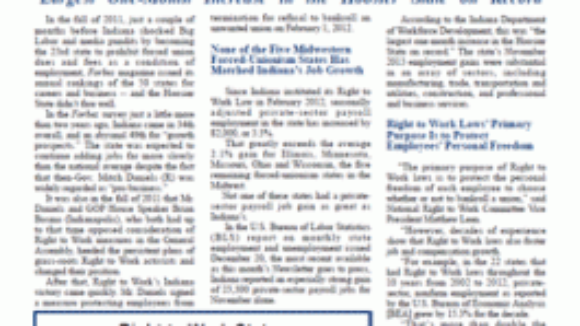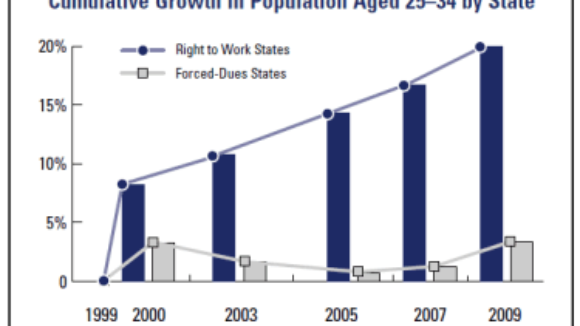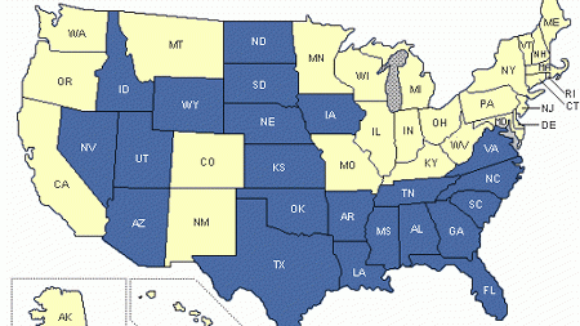Job Growth Surges in Right to Work Indiana
According to the Indiana Department of Workforce Development, this was “the largest one-month increase in the Hoosier State on record.” The state’s November 2013 employment gains were substantial

According to the Indiana Department of Workforce Development, this was “the largest one-month increase in the Hoosier State on record.” The state’s November 2013 employment gains were substantial

Lorain, Ohio is finding that union-only project labor agreements (PLAs) do not live up to union bosses’ promises. PLAs costs taxpayers both in taxes and time, estimates range from 31% to 60% increased costs on construction projects. Richard Payerchin from…

If you live in the following states, Colorado, Florida, New Hampshire, Nevada, Ohio, Pennsylvania, Wisconsin and Virginia, you will have the privileged of seeing millions of dollars of forced union dues money spent to re-elect President Obama. The Service…

If you live in the following states, Colorado, Florida, New Hampshire, Nevada, Ohio, Pennsylvania, Wisconsin and Virginia, you will have the privileged of seeing millions of dollars of forced union dues money spent to re-elect President Obama. The Service…

Matt Mayer of the Buckeye Institute debunks the long-term economic growth without Right To Work freedom is sustainable. Mayer uses a Columbus Dispatch reporter Joe Hatlett column that featured Former Michigan Gov. Jennifer Granholm to expose the fact that corporate welfare and reduced regulations ignore the “proverbial elephant in the room weighing down” compulsory union states like Indiana, Ohio, Illinois,, and Michigan. From Matt Mayer’s post: “With Michigan bleeding jobs and tax revenues, Granholm said she followed the corporate playbook in her attempt to close a huge state budget deficit and make Michigan more competitive. ‘In listening to the business community, I cut takes [sic] 99 times, and I ended shrinking government more than any state in the nation. In my two terms, I cut more by far than any state in the nation. And yet, we still have the highest unemployment rate. There was no correlation.’ Granholm conceded that streamlining business regulations and lowering taxes — Kasich’s economic recovery mantra — are helpful, but they aren’t a panacea…[l]abor costs, help with start-up costs and proximity to markets are other factors.” Hallett and Governor Granholm fail to mention why streamlining regulations and lowering taxes aren’t helping the northern states (located within 50 percent of the U.S. population and with low start-up costs) compete against the southern and western states. Instead, Hallett ignores the obvious answer and pleads for an end to corporate pork (with which we enthusiastically agree). The reason Michigan and Ohio can’t compete is that the southern and western states already have fewer regulations and lower taxes, so “catching up” with those states still leaves the proverbial elephant in the room weighing down the northern states. Plus, those states are also pushing for lower taxes and fewer regulations, so the northern states are perpetually behind them. The elephant, which Governor Granholm does hint at, is labor costs, or, more specifically, unionized labor costs (see: General Motors and the United Auto Workers). As I noted in Six Principles for Fixing Ohio, “Of course, tax and regulatory burdens also impact a state’s economy. Although many of the forced unionization states have heavy tax burdens and many of the worker freedom states have light tax burdens, some heavily taxed worker freedom states (Idaho, Nevada, and Utah) had the strongest sustained job growth from 1990 to today. Similarly, a few moderately taxed forced unionization states still had weak job growth (Indiana, Illinois, and Missouri). The combination of both a heavy tax burden and forced unionization is deadly when it comes to job growth, as 11 of the 15 worst performing states are ranked in the top 20 for high tax burdens.” If Ohio and the other states from Missouri to Maine want to truly compete with Texas, Georgia, and South Carolina, then those states need to enact laws that protect the rights of workers not to join a labor union to get a job.

Matt Mayer of the Buckeye Institute debunks the long-term economic growth without Right To Work freedom is sustainable. Mayer uses a Columbus Dispatch reporter Joe Hatlett column that featured Former Michigan Gov. Jennifer Granholm to expose the fact that corporate welfare and reduced regulations ignore the “proverbial elephant in the room weighing down” compulsory union states like Indiana, Ohio, Illinois,, and Michigan. From Matt Mayer’s post: “With Michigan bleeding jobs and tax revenues, Granholm said she followed the corporate playbook in her attempt to close a huge state budget deficit and make Michigan more competitive. ‘In listening to the business community, I cut takes [sic] 99 times, and I ended shrinking government more than any state in the nation. In my two terms, I cut more by far than any state in the nation. And yet, we still have the highest unemployment rate. There was no correlation.’ Granholm conceded that streamlining business regulations and lowering taxes — Kasich’s economic recovery mantra — are helpful, but they aren’t a panacea…[l]abor costs, help with start-up costs and proximity to markets are other factors.” Hallett and Governor Granholm fail to mention why streamlining regulations and lowering taxes aren’t helping the northern states (located within 50 percent of the U.S. population and with low start-up costs) compete against the southern and western states. Instead, Hallett ignores the obvious answer and pleads for an end to corporate pork (with which we enthusiastically agree). The reason Michigan and Ohio can’t compete is that the southern and western states already have fewer regulations and lower taxes, so “catching up” with those states still leaves the proverbial elephant in the room weighing down the northern states. Plus, those states are also pushing for lower taxes and fewer regulations, so the northern states are perpetually behind them. The elephant, which Governor Granholm does hint at, is labor costs, or, more specifically, unionized labor costs (see: General Motors and the United Auto Workers). As I noted in Six Principles for Fixing Ohio, “Of course, tax and regulatory burdens also impact a state’s economy. Although many of the forced unionization states have heavy tax burdens and many of the worker freedom states have light tax burdens, some heavily taxed worker freedom states (Idaho, Nevada, and Utah) had the strongest sustained job growth from 1990 to today. Similarly, a few moderately taxed forced unionization states still had weak job growth (Indiana, Illinois, and Missouri). The combination of both a heavy tax burden and forced unionization is deadly when it comes to job growth, as 11 of the 15 worst performing states are ranked in the top 20 for high tax burdens.” If Ohio and the other states from Missouri to Maine want to truly compete with Texas, Georgia, and South Carolina, then those states need to enact laws that protect the rights of workers not to join a labor union to get a job.

(Source: March 2011 NRTWC Newsletter) Millions Have 'Voted With Their Feet' For Better Opportunities For a combination of reasons, nationwide the number of young adults aged 25-34 is growing far more slowly than is the number of Americans aged 55 and older. In 1999, according to the U.S. Census Bureau, there were 37.94 million people aged 25-34 living in the U.S. By 2009, there were 41.57 million people nationwide in that age bracket. That's a 9.6% increase. Over the same decade, the number of Americans aged 55 and older soared from 57.93 million to 74.36 million, a whopping 28.4% increase! The nationwide decline in young employees' population share, relative to that of Americans nearing or in their retirement years, is obviously an impediment to economic growth. Eleven Non-Right to Work States Suffered Young-Adult Population Declines

NRTW President Mark Mix from the Investor's Business Daily: In Wisconsin, union officials — with support from the Obama White House — continue to orchestrate illegal teacher strikes, lead angry mass protests at the state capitol and picket the residences of legislators to safeguard Big Labor's government-granted monopoly bargaining power over hundreds of thousands of Badger State public employees. Raucous union rallies and intimidation of elected officials and their families in support of Big Labor's purported "right" to unchallenged monopoly bargaining control are occurring in other states as well. Americans learning about organized labor's battles in Wisconsin, Ohio, Indiana and other states from TV, radio and newspaper reports may understandably be confused about what is at stake, especially if they have no personal experience with unions themselves. From afar, it's easy to draw the conclusion that public employees' right to join a union is at stake. But that is hardly the case. Public employees' freedom to join and pay dues to labor organizations is already legally protected across the U.S. and is not being challenged anywhere. What reform-minded elected officials are seeking to curtail, and in some cases even abolish, is government union chiefs' legal power to force public servants into a union as a condition of employment. Under the current labor laws of nearly half of the states, government union officials have been explicitly authorized to force all public employees in a workplace to pay union dues or be fired, as long as a majority of their fellow employees (among those expressing an opinion) support unionization. Such forced-unionism laws, which Big Labor is now fighting furiously to keep on the books in the face of increasingly intense public opposition, actually trample on, rather than protect, employees' freedom to make personal decisions about unionism.

Americans overwhelming choose Right to Work freedom when they are given the choice. As Diana Furchtgott-Roth points out in her Real Clear Politics article, people prefer the choice to job or not a join…